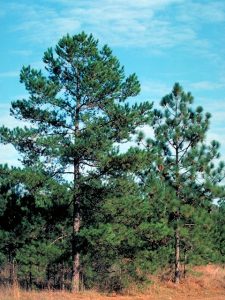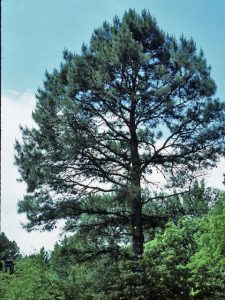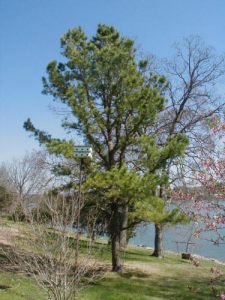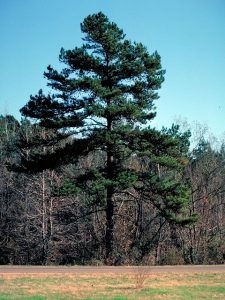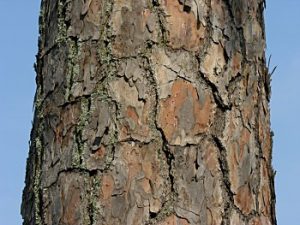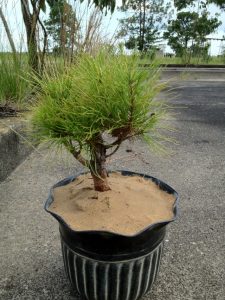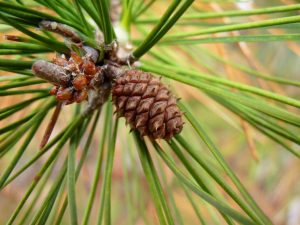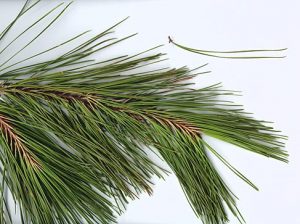Shortleaf Pine
The Shortleaf Pine is a medium- to large-sized tree, indigenous to the eastern United States. It’s a unique and ecologically important tree species found primarily in the southeastern and central United States. The tree varies in form – sometimes straight, sometimes twisted with an asymmetrical crown. It can tolerate varied soil and site conditions and maintains steady growth rate for a long period.
Unique Features of Shortleaf Pines:
1. Needles and Cones:
The Shortleaf Pine has long, slender needles that typically grow in bundles of two or three. These needles are about 3 to 5 inches long, giving the tree a soft and graceful appearance. The cones are small to medium-sized, typically 2 to 3 inches long, and have a slightly prickly texture, which helps protect the seeds inside.
2. Bark and Wood:
The bark of the Shortleaf Pine is generally reddish-brown to grayish and has a rough texture that becomes scaly with age. This gives the tree a distinctive appearance compared to other pines. The wood is soft, light, and straight-grained, making it valuable for lumber and paper products, though it is not as commercially sought after as other pines.
3. Adaptability to Fire:
One of the most unique features of the Shortleaf Pine is its ability to regenerate after fire. The species is known to be fire-adapted, with mature trees having thick bark that helps protect them from low-intensity fires. In fire-prone ecosystems, Shortleaf Pine often thrives in the aftermath of fire, as it can quickly sprout new growth from its roots and seeds, allowing it to outcompete other less fire-resistant species.
4. Drought Resistance:
The Shortleaf Pine is more drought-tolerant compared to many other pine species. Its deep root system allows it to access water from deeper soil layers, which is especially beneficial in areas that experience periods of dry conditions. This adaptability makes it a valuable species in maintaining forest health during changing climates.
Ecological Importance of the Shortleaf Pine:
1. Habitat for Wildlife:
The Shortleaf Pine provides essential habitat for various wildlife species. Its dense canopy offers shelter and nesting sites for birds such as woodpeckers, hawks, and the endangered Red-cockaded Woodpecker. Small mammals, including squirrels and chipmunks, also depend on the tree for food and shelter. The pine’s seeds and cones serve as food for a variety of birds and rodents, playing a critical role in the local food web.
2. Forest Composition and Succession:
The Shortleaf Pine is an important species in forest composition, particularly in mixed hardwood-pine forests. It is often found in association with other pines like the Loblolly Pine and hardwood species like oaks and hickories. The tree is a pioneer species that helps initiate forest succession in disturbed or cleared areas, and over time, it can create a more stable and diverse forest ecosystem.
3. Soil Stabilization:
The tree’s deep and expansive root system helps prevent soil erosion by stabilizing the ground. In areas prone to disturbance, such as hillsides or riverbanks, Shortleaf Pines help keep the soil in place and reduce the risk of landslides or degradation caused by runoff. This function is especially important in areas where other vegetation may not yet have established.
4. Climate Resilience:
The Shortleaf Pine’s ability to survive in a variety of climates—from the dry conditions of the Ozark Mountains to the humid environments of the southeastern U.S.—makes it an important species in maintaining forest health in a changing climate. Its resilience to drought and fire, along with its capacity to regenerate quickly after disturbances, helps preserve forest ecosystems in areas vulnerable to climate stressors.
5. Carbon Sequestration:
As with all trees, the Shortleaf Pine plays a significant role in mitigating climate change by absorbing carbon dioxide from the atmosphere. It stores carbon in its biomass (trunk, roots, branches), helping reduce greenhouse gases. Its rapid growth in early years allows it to sequester carbon quickly, contributing to the reduction of atmospheric CO2 levels.
Scientific Classification
| Kingdom | Plantae |
| Division | Pinophyta |
| Class | Pinopsida |
| Order | Pinales |
| Family | Pinaceae |
| Genus | Pinus |
| Species | Pinus echinata |
Quick Information
| Other Names | Southern Yellow Pine, Oldfield pine, Shortstraw pine, Shortleaf Yellow Pine, Arkansas Soft Pine |
| Similar Species | Virginia Pine |
| Size | Height: 20-30 m (66–98 ft)Trunk diameter: 0.5–0.9 m |
| Leaves | Needle-shaped, mixed in bundles of two or three; 7-11 cm (2.8–4.3 in) long |
| Cones | 4-7 cm (1.6–2.8 in) long, consists of thin scales with a transverse keel and a short prickle; it is persistent but, opens at maturity |
| Bark | Dark and scaly when young, turning reddish-brown with fragmented rectangular plates upon maturity, there are small resin pores on the plates; it is 2 to 3 cm (0.8 to 1.0 in) thick |
| Tree Type | Evergreen |
| Shape at Maturity | Crown is rounded to cone-shaped |
| Distribution/Range | New York State, northern Florida, eastern Oklahoma, eastern Texas |
| Hardiness Zones | 6a-8b |
| Growth Rate | Grows slower when young; later, it becomes steady |
| Lifespan | Around 200 years |
| Growing Conditions | Soil conditions: Grows well on drier, well-drained, and less fertile sites in full sun, requires low nutrients, does not grow well on soils with high calcium content, high pH, and poor soil aerationWater requirements: Fairly drought resistant Sunlight: Tolerates partial shade |
| Diseases/Pests | Littleleaf disease, root rot, red heart; Nantucket pine tip moth, redheaded pine sawfly, loblolly pine sawfly, pitch-eating weevil, pales weevil |
| Flowering/Fruiting | Late March to late April |
| Seed Production | Bears seeds at around 20 years of age |
| Dispersal of Seeds | Late October to early November |
| Wildlife Value | Provides excellent nesting sites for woodpeckers and shelter to other species; deer graze on young sprouts while some animals feed on the seeds; the shortleaf pine forests aid in preventing sandy soil from erosion |
| Uses | Good source of wood pulp, lumber, and plywood veneer |
| IUCN Conservation Status | Least Concern |
Interesting Facts
- Like most pines, Shortleaf pine is a popular bonsai.
- Young trees may sprout from the base especially after fires or mowing which differentiate them from other southern pines.
- A deep taproot develops early in its life cycle, which helps it to grow on poor sites.
- The plant has excellent fire adaptability – its thick platy bark protects the cambium from fire injury, its cones with plentiful seed crops aid seedlings to recover after a fire, and it can control the production of flammable resins.
References:
- https://plants.ces.ncsu.edu/plants/pinus-echinata/
- https://urbanforestrysouth.org/resources/library/citations/pinus-echinata-shortleaf-pine/fss_get/file
- https://en.wikipedia.org/wiki/Pinus_echinata
- https://www.fs.usda.gov/database/feis/plants/tree/pinech/all.html
- http://www.missouribotanicalgarden.org/PlantFinder/PlantFinderDetails.aspx?kempercode=v130
Published on August 20th 2016 by Mark Matzeldelaflor under Pine.
Article was last reviewed on 5th December 2024.


